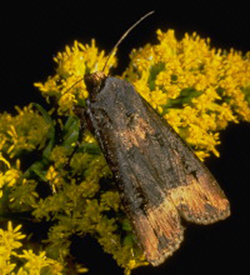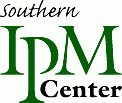Black Cutworm Inset Trap Data
With a wing span of 1 to 1½ inches, the adult black cutworm moth has long, narrow dark forewings and white hind wings. The forewings are brown to black in the basal two thirds and clay colored near the tips. There is a distinct black "dagger-like" dash near the front margin of each forewing. The moths are nocturnal and can be difficult to distinguish from other species of cutworm moths.

Black Cutworm Moth. Photo courtesy of David Shetlar, Ohio State University.
Black cutworm moths can appear in traps throughout the growing season starting in March in Kentucky. Corn should be scouted for cutworms from planting through mid-June. For information on scouting and management techniques see IPM-2 Kentucky IPM Manual for Field Crops-Corn and ENT-59 Cutworm Management in Corn. In Kentucky, outbreaks of black cutworms are from moths migrating from the south. Late planting date, history of cutworm damage, soybean surface litter, and fair to poor drainage or overflow land are all characteristics of fields susceptible to cutworm damage.
For information on Black cutworms in soybeans see EntFact132-Cutworms in Kentucky Soybeans.
To view the data that includes temperature and accumulated degree days you will need Microsoft Excel®.
University of Kentucky Research Center, Princeton,KY
| 1993 | 1994 | 1995 | 1996 | 1997 | 1998 |
| 1999 | 2000 | 2001 | 2002 | 2003 | 2004 |
| 2005 | 2006 | 2007 | 2008 | 2009 | 2010 |
| 2011 | 2012 | 2013 | 2014 | 2015 | 2016 |
| 2017 | 2018 | 2019 | 2020 | 2021 | 2022 |
| 2023 | 2024 | 2025 |
University of Kentucky Spindletop Farm, Lexington, KY
| 2007 | 2008 | 2009 | 2010 | 2011 | 2012 |
| 2013 | 2014 | 2015 | 2016 | 2017 | 2018 |
| 2019 | 2020 | 2021 | 2022 | 2023 | 2024 |
| 2025 |
Insect trap data are provided for educational purposes only. Weather data provided by the University of Kentucky Agricultural Weather Center and Kentucky Mesonet. Weather data if used for legal purposes must be certified by NCDC, National Climate Data Center.


